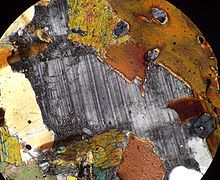| Plagioclase | |
|---|---|
 A photomicrograph of a plagioclase crystal (gray) under cross polarized light. The plagioclase crystal shows a distinct banding effect called polysynthetic twinning. | |
| General | |
| Category | Feldspar mineral group, tectosilicate |
| Formula (repeating unit) | NaAlSi3O8 – CaAl2Si2O8 |
| IMA symbol | Pl[1] |
| Crystal system | Triclinic |
| Crystal class | Pinacoidal (1) (same H-M symbol) |
| Space group | C1 |
| Identification | |
| Color | White, gray, or bluish white |
| Mohs scale hardness | 6–6.5 |
| Luster | Vitreous |
| Streak | White |
| Diaphaneity | Transparent to translucent |
| Specific gravity | 2.62 (albite) to 2.76 (anorthite)[2] |
| Optical properties | Biaxial (+) albite, biaxial (-) anorthite[2] |
| Refractive index | Albite: nα 1.527, nβ 1.532 nγ 1.538 Anorthite: nα 1.577 nβ 1.585 nγ 1.590[2] |
| Solubility | Albite insoluble in HCl, anorthite decomposed by HCl[2] |
| References | [3] |


Plagioclase (/ˈplædʒ(i)əˌkleɪs, ˈpleɪdʒ-, -ˌkleɪz/ PLAJ-(ee)-ə-klayss, PLAYJ-, -klayz)[4] is a series of tectosilicate (framework silicate) minerals within the feldspar group. Rather than referring to a particular mineral with a specific chemical composition, plagioclase is a continuous solid solution series, more properly known as the plagioclase feldspar series. This was first shown by the German mineralogist Johann Friedrich Christian Hessel (1796–1872) in 1826. The series ranges from albite to anorthite endmembers (with respective compositions NaAlSi3O8 to CaAl2Si2O8), where sodium and calcium atoms can substitute for each other in the mineral's crystal lattice structure. Plagioclase in hand samples is often identified by its polysynthetic crystal twinning or "record-groove" effect.
Plagioclase is a major constituent mineral in Earth's crust and is consequently an important diagnostic tool in petrology for identifying the composition, origin and evolution of igneous rocks. Plagioclase is also a major constituent of rock in the highlands of the Moon. Analysis of thermal emission spectra from the surface of Mars suggests that plagioclase is the most abundant mineral in the crust of Mars.[5]
Its name comes from Ancient Greek πλάγιος (plágios) 'oblique' and κλάσις (klásis) 'fracture', in reference to its two cleavage angles.
- ^ Warr, L.N. (2021). "IMA–CNMNC approved mineral symbols". Mineralogical Magazine. 85 (3): 291–320. Bibcode:2021MinM...85..291W. doi:10.1180/mgm.2021.43. S2CID 235729616.
- ^ a b c d Klein, Cornelis and Cornelius S. Hurbut, Jr.; Manual of Mineralogy, Wiley, 20th ed., 1980, pp.454-456 ISBN 0-471-80580-7
- ^ Plagioclase Mineral Data, WebMineral.com
- ^ "Plagioclase". Merriam-Webster.com Dictionary. Merriam-Webster.
- ^ Milam, K. A.; et al. (2010). "Distribution and variation of plagioclase compositions on Mars". Journal of Geophysical Research: Planets. 115 (E9). Bibcode:2010JGRE..115.9004M. doi:10.1029/2009JE003495.